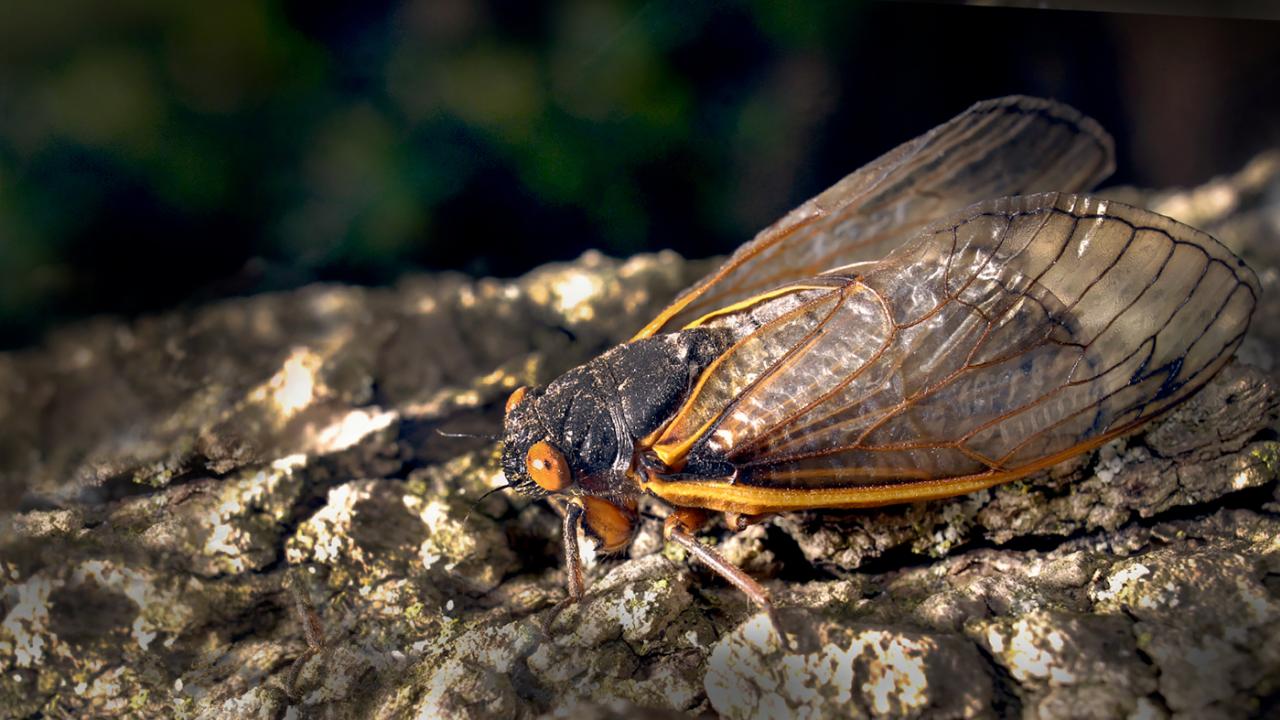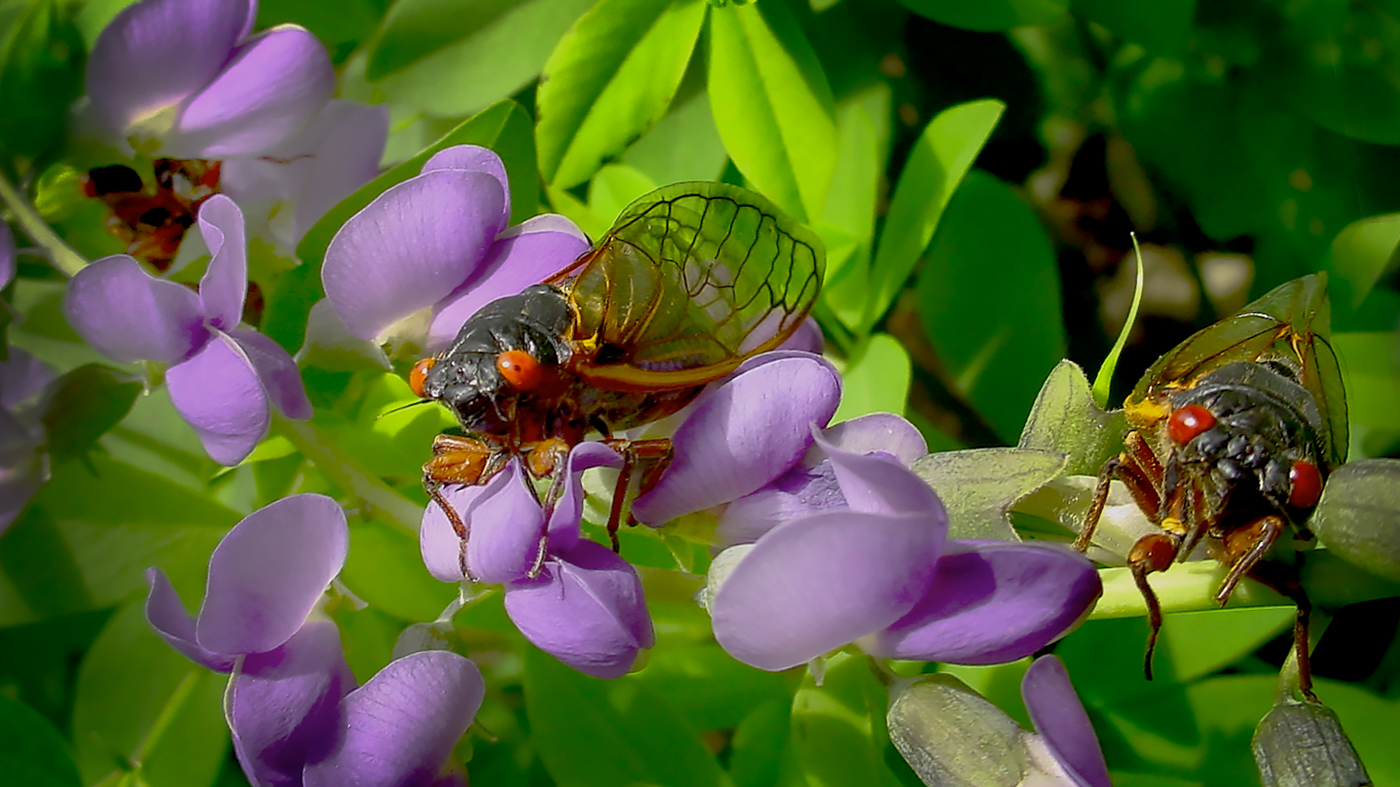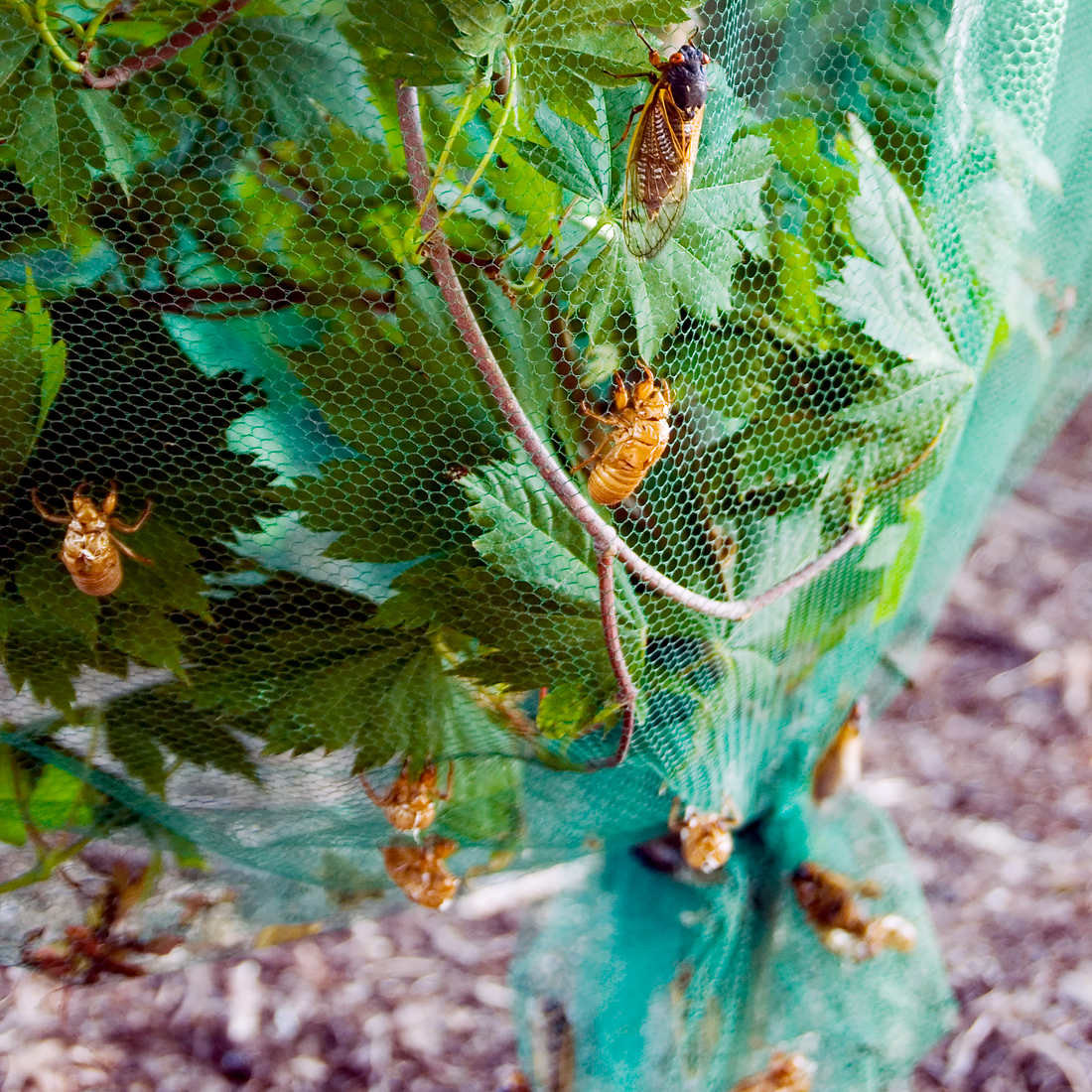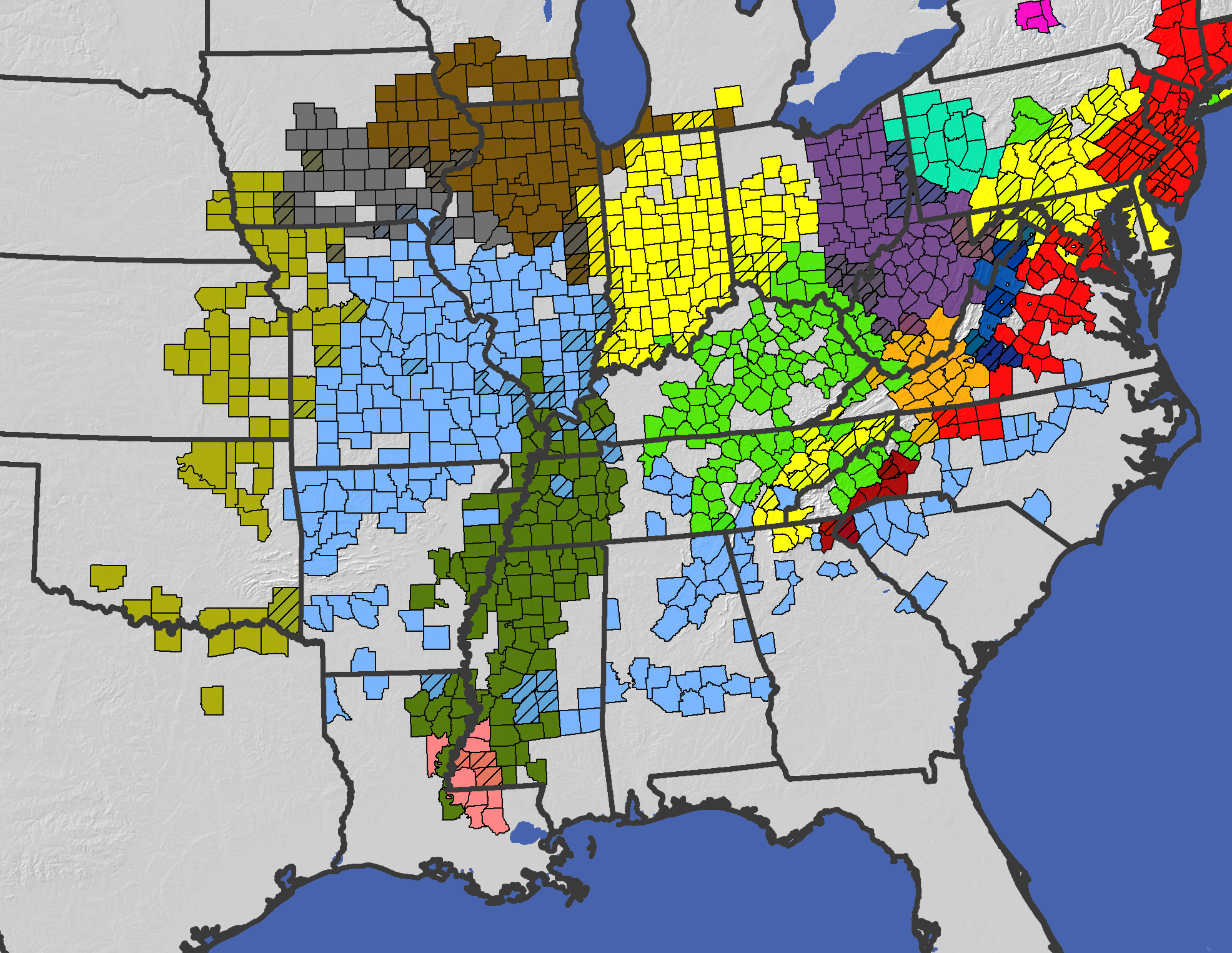
Cicadas
are here!
Let us introduce you to them.
They are the symphony-makers, the talk of the town, the pro slumberers. Of course, we’re talking about periodical cicadas (Magicicada). In May and June 2024, Illinoisans are witnessing the dual emergence of two broods of periodical cicadas at the same time, something that hasn’t happened in 221 years. Truly, it’s a once-in-a-lifetime event. Here’s their itinerary: They’ll mate, they’ll lay eggs, the eggs will hatch, and the nymphs will go below ground to feed and await their next appearance in 2041.
Meet Magicicada
What’s so amazing about the periodical cicada (Magicicada)? Their long life cycle. After hatching, the immature cicadas, called nymphs, spend 17 or 13 years underground feeding on roots, before emerging in the spring and transforming into adult cicadas.
The periodical cicada is a native North American insect species inhabiting the mid and eastern United States and, according to Penn State University, is found nowhere else in the world.
Periodical cicadas are not the same species as annual cicadas. Even though annual cicada nymph development cycles are also long and variable, they are not synchronized like the periodical cicadas. Annual cicadas mature at different times, which is why we see them each year; they’re green with black eyes and are also larger than periodical cicadas, approximately 1 to 2 inches in length, and appear from July to September. Periodical cicadas are black with orange wing veins and red eyes, approximately ¾ to 1¼ inches in length, and are active in May and June.
Life Cycle
The life cycle of cicadas is a mystery to entomologists. Periodical cicadas require either 13 or 17 years in the nymph stage, developing underground, and mature very slowly. They are synchronized to emerge en masse, every 13 or 17 years. Their 17-year life span makes them the longest-lived insect known. There are two kinds of periodical cicadas, which are distinguished by the time required to develop into adulthood: the 17-year cicadas, which appear in the north, and the 13-year cicadas, which appear in the south.
The 17-year periodical cicadas last emerged in the Chicago region in 2007. Nymphs emerge from the ground when soil temperatures warm to approximately 64 degrees Fahrenheit, usually sometime in May. They come out after sunset, leaving behind visible exit holes, and quickly crawl to any nearby vertical structure, preferably a tree or shrub. Then they shed their skins as they molt into adults, leaving behind empty shells. Shortly after molting, their wings unfurl and their yellow-white skin darkens as their exoskeleton completely hardens.
Mating
Adults begin mating after they have completely matured, usually within a few days after they emerge, and stay alive for about three to four weeks. Shortly after mating, females climb to living trunks, branches, and twigs, where they split the bark and deposit about 20 eggs per slit. Adult females mate many times and are capable of laying up to 600 eggs during their lifetime. Approximately six to ten weeks after eggs are laid, ant-like juveniles hatch and drop to the ground, where they burrow from a few inches to more than a foot into the soil. They remain underground as nymphs, feeding on tree and shrub roots for years.
Male cicadas will call females to mate by vibrating their tymbals, which are two rigid, drum-like membranes on the undersides of their abdomens—females don’t have tymbals, so they can’t produce the same sounds. Different species of cicadas produce different songs, and males respond to the calls of other males, creating a chorus of “singing” cicadas that can be as loud as a lawn mower.
Appetite
Cicadas are often mistakenly referred to as locusts, which are members of the grasshopper family who have chewing mouthparts; cicadas have sucking mouthparts and do not chew. Even though adult cicadas suck on plants for nutrition, they feed very little as adults. Periodical cicadas will not bite humans either. They have been known to land on people, but they cause no harm. Developing nymphs have a bigger appetite. They feed on plant roots underground.
In Your Appetite
Cicadas are edible, usually best eaten in the nymph stage; they're even considered a delicacy in many countries, as well as in different parts of the United States. Some claim that cicadas are high in protein, but research conducted at the University of Cincinnati’s College of Engineering determined that cicadas may contain high levels of mercury. Diners therefore are cautioned to limit their ingestion of these "delicacies" to just a few.

In Your Garden
Adult females are known to damage woody plants above ground as they split the bark on small-diameter limbs and branches for egg laying. Healthy and larger-diameter trees and shrubs can easily heal the ½- to 1-inch slits; smaller, younger trees might be more vulnerable.
Treatment & Solutions
Newly planted and small-diameter trees and shrubs can be protected with fine netting, cheesecloth, or row-cover fabric tied securely at the base, to keep nymphs from crawling up the trunks upon emergence, as well as preventing females from slitting bark to lay eggs.
Remove small, damaged branches to keep eggs from hatching and future populations low. Also, delay planting new trees and shrubs until adult periodical cicadas are gone, usually by mid-July.
The use of chemical sprays to kill adult periodical cicadas is not recommended. It’s not effective, and using insecticides will kill beneficial insects and can injure natural predators such as birds, raccoons, skunks, and moles.


Wondering whether to protect your tree?
Most trees and shrubs will bounce back from cicada damage just fine—but if you’re wondering about a particular tree, and these factors apply, consider wrapping it in tulle until the periodical cicadas are back underground:
The tree has pencil-sized branches, ¼ inch to ½ inch thick
The tree is young/unestablished—generally 6 feet or shorter
The tree is high-value or “special-to-you”
Note that if you live near woods, you will likely see more cicadas. The bottom line: If you’re unsure and want to be cautious, wrapping a tree won’t harm it!
Get the buzz from an expert
Plant Health Care Supervisor Tom Tiddens shares how to net and protect your small high-value trees from cicadas.
Questions about what to expect when the talk of the town arrives? Tom Tiddens, plant health care supervisor at the Chicago Botanic Garden, answers our most pressing inquiries.
Q: When should we expect to see periodical cicadas?
They’ll come out when the soil temperature at 8 inches deep reaches 64 degrees Fahrenheit. It’s hard to predict when that will happen.
Q. Are my plants and pets safe? Am I safe? (Spoiler: Yes!)
They don’t bite or sting and won’t hurt you or your pets. Any damage to plants is only concerning for small trees with mostly small branches.
Q. Is there anything we can do to protect our small trees?
You can wrap them in a fine mesh, and delay planting new trees until after the cicadas are gone. We do NOT recommend using insecticides for cicada management.
Q. What’s so special about this year’s cicadas?
Brood XIII (a 17-year periodical cicada type) and Brood XIX (a 13-year periodical cicada type) have synced their calendars and are emerging at the same time; the last time this happened was 221 years ago, in 1803.
Q. I’ve never seen one before. Where can I get a good look?
Northern Illinois is the place for Brood XIII, but they’ll also show up in parts of Wisconsin, Iowa, Indiana, and Michigan. Southern Illinois will host Brood XIX, which touches 14 states total. This doesn’t mean twice the cicadas. A narrow part of the state where the broods overlap could see the highest numbers. In the Chicago area, only one brood will be present.
Q. Will we still have the annual cicadas this summer?
Yes, annual cicadas (aka “dog-day cicadas”) are a different species and will still show up this year, during their usual period from July to September.
Q. What’s the difference between periodical cicadas and annual cicadas?
Periodical cicadas are black with orange wing veins and red eyes and about an inch long; annual cicadas are green with black eyes and can be up to 2 inches long.
Q. What’s the life cycle of a periodical cicada?
Juveniles (nymphs) develop underground throughout their 13- or 17-year cycle and complete their final molt into adulthood within a few days after emerging. Male cicadas sing to attract females; after mating, the female makes slits in pencil-sized branches to lay eggs.
In six to ten weeks, eggs hatch and ant-sized nymphs drop to the ground and burrow underground, waiting for their next arrival.
Q. What role do periodical cicadas play in the ecosystem?
When they emerge they temporarily disrupt the food chain, because they become a food source for many other animals—even people. We may see an increase in other insects as a result, because predators (like bats) may favor an easy cicada meal over a tiny insect meal.
Q. Is there anything important to know or keep in mind besides the noise?
Keep in mind that this is an incredible natural occurrence; get outside and experience it—there’s nothing to fear from periodical cicadas!
Mapping Periodical Cicadas
Wondering where periodical cicadas will be emerging in 2024? This map from the USDA Forest Service shows the geographical areas of all known broods of periodical cicadas—and two of them are emerging this year:
Brood XIII (17-year cicadas) are shown in brown
Brood XIX (13-year cicadas) are shown in light blue
…As you can see, both of them call Illinois home! Other cicada broods, shown in different colors, are synced up for different years; click the map button below for more.
View the Periodical Cicada Map
Liebhold, A. M., Bohne, M. J., and R. L. Lilja. 2013. Active Periodical Cicada Broods of the United States. USDA Forest Service Northern Research Station, Northeastern Area State and Private Forestry.


